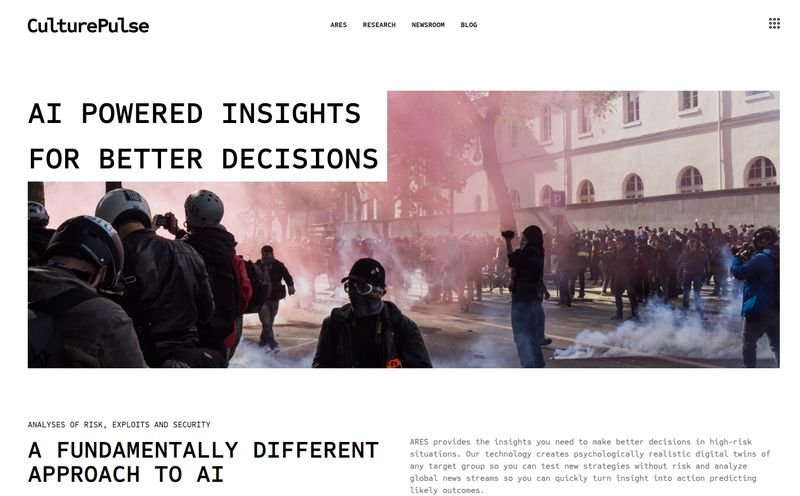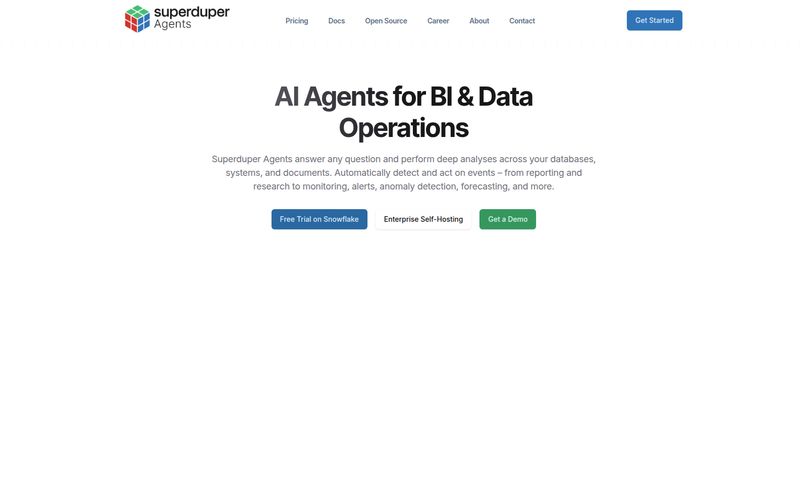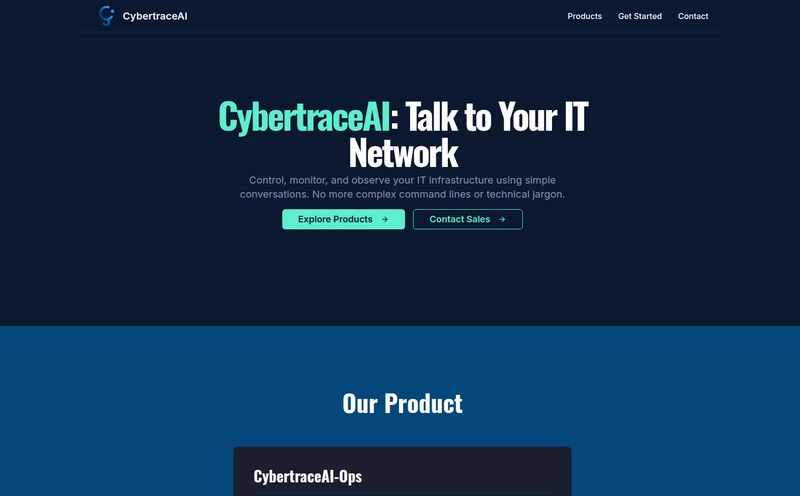I swear, some days I spend more time wrestling with SQL syntax than I do actually looking at the data. You know the feeling. A simple question from the marketing team turns into a 30-minute battle with a LEFT JOIN that just refuses to cooperate. It's the bane of our existence, the necessary evil of data analytics. So when a tool pops up promising to be my 'personal data analyst,' my ears definitely perk up.
The tool in question is SnowBrain. And in a moment of pure, delicious irony, my very first interaction with this AI was a security check to prove I was human. You really can't make this stuff up. The machine wanted to verify me before I could verify it. A sign of the times, I guess.
So What Exactly is SnowBrain?
Once I proved my humanity to the digital gatekeeper, I got to the core of it. SnowBrain pitches itself as an open-source AI data analyst built specifically for Snowflake users. It’s not trying to be a jack-of-all-trades. It's a specialist, a tool designed to do one job really well: help you get insights from your Snowflake data without writing a single line of SQL yourself.
Think of it as a translator. You speak to it in plain English, and it speaks fluent SQL back to your database. It’s an intriguing proposition, especially for teams where not everyone is a code wizard. The idea of democratizing data access is something we've been talking about for years in the SEO and analytics world, and this feels like a genuine step in that direction. And the fact that its open-source is a huge plus for folks like me who love to tinker and avoid vendor lock-in.

Visit SnowBrain
The Features That Actually Matter
Okay, so it talks to data. Lots of tools claim to do that. But what makes SnowBrain stand out? It's not one single thing, but how a few key features work together. It’s less about a checklist and more about the workflow it creates.
Talking to Your Data in Plain English
This is the headline act. The ability to ask a question like, “What were our top 5 most viewed blog posts in the last quarter?” and have it generate the correct SQL query is, frankly, a game-changer. It lowers the technical barrier to entry so dramatically. Suddenly, your content manager or your sales lead can self-serve their most common data requests, freeing up the data team to focus on the really gnarly, deep-dive analysis. This isn't just about convenience; it's about speed and efficiency. The time from question to insight gets slashed.
More Than Just Numbers, It Draws Pictures Too
Getting a table of data is fine. But a visualization? That’s where insights truly click into place for most people. SnowBrain doesn't just fetch the raw data; it can generate charts and graphs from it. That same question about top blog posts could instantly become a bar chart, making the winner obvious at a single glance. As they say, a bar chart is worth a thousand rows. This visual component is critical because it's how you spot trends anomalies and opportunities without having to squint at spreadsheets for an hour.
It Actually Remembers What You Said
For my money, this might be the most underrated feature. SnowBrain has conversational memory. You can ask a follow-up question without restating all the previous context.
Let’s continue our example:
You: “What were our top 5 most viewed blog posts in the last quarter?”
(SnowBrain shows you a chart)
You: “Okay, cool. Now show me just the ones from the ‘SEO’ category.”
It just knows. It remembers the “top 5” and “last quarter” part. I’ve lost count of how many times I've had to copy-paste a huge query just to add one tiny WHERE clause. This contextual awareness mimics a real conversation and removes so much repetitive friction from the analysis process. It’s a small detail that makes a massive difference in usability.
Let's Be Real, The Potential Hurdles
I’m an optimist, but I’m also a realist who's been burned by overhyped tech before. SnowBrain looks incredibly promising, but it's important to go in with your eyes open. It’s not perfect, and its strengths are tied to some specific limitations.
A Promising Prototype, Not a Finished Product
The key word here is “prototype.” This means you should expect some rough edges. It might not handle every convoluted, off-the-wall query you can dream up. There could be bugs. It's built for the most common use cases. I like to think of it as a brilliant but young intern. It's eager, it's fast, and it can handle most of the day-to-day tasks you throw at it. But you probably wouldn’t ask it to single-handedly architect your entire company's data strategy on its first day. For early adopters and developers, this is exciting. For a large enterprise looking for a plug-and-play, fully-supported solution, it might be a bit too early.
The Snowflake Singularity
This tool is all-in on Snowflake. If your company's data lives in Google BigQuery, Amazon Redshift, or a humble PostgreSQL database, then SnowBrain, in its current form, is not for you. This isn't really a flaw, so much as a specialization. By focusing only on Snowflake, it can be better tuned to its specific SQL dialect and architecture. But it does mean its audience is, by definition, limited to those within that ecosystem. If you're a Snowflake shop, great. If not, you'll have to look elsewhere.
Who Should Give SnowBrain a Spin?
So, is it right for you? It really depends on who you are and what you need.
- The Overworked Data Analyst: If you're spending half your day answering the same five questions from different departments, SnowBrain could be a bot that takes that load off your plate.
- The Curious Marketer or PM: Want to quickly check a campaign's performance or a feature's adoption without filing a ticket and waiting two days? This is your entry point.
- The Scrappy Startup: If you're running on Snowflake and want powerful analytics without the hefty price tag of some enterprise BI tools, the open-source nature of SnowBrain is incredibly appealing.
- The Open-Source Developer: For anyone who loves to see how things work, contribute to a project, or build custom tools, SnowBrain is a fantastic foundation to play with.
What's the Price Tag on This AI Brain?
This is the easy part. It’s open-source, so the price tag is effectively zero. There's no pricing page because you don't buy a license; you use the code. However, “free” in the open-source world doesn’t mean zero cost. The 'cost' is your own team's time for setup, hosting, and maintenance. You’ll need some technical chops to get it up and running. This is a very different model from a polished SaaS tool where you pay a monthly fee for a service that just works. For many, especially those with development resources, this trade-off is more than worth it.
Frequently Asked Questions about SnowBrain
- Is SnowBrain difficult to set up?
- As an open-source prototype, you should expect some technical setup. It's not a one-click install like a typical SaaS application. You'll likely need some comfort with deploying applications and configuring them to connect to your Snowflake instance.
- Can it handle really complex SQL queries?
- It's designed to excel at conversational, high-frequency queries. For extremely complex, multi-level nested queries with obscure functions, you'll probably still want a human data expert to write and optimize it. Think of it as a tool for the 80%, not the edge-case 20%.
- Is my data safe with SnowBrain?
- A huge advantage of its open-source, self-hosted nature is that your data security is in your hands. The tool connects to your Snowflake warehouse, but the data isn't being shipped off to some random third-party server. You control the environment. Of course, this means you are also responsible for securing that environment.
- How does SnowBrain compare to something like ChatGPT with data analysis?
- It's all about specialization. Generalist tools like ChatGPT are incredibly powerful, but they're like a Swiss Army knife. SnowBrain is a scalpel. Because it’s built specifically for Snowflake, it has a deeper, more inherent understanding of the platform's syntax and structure, which can lead to more accurate and efficient queries.
- Can I contribute to the SnowBrain project?
- Absolutely! That's the whole point of open source. If you have ideas, find a bug, or want to add a feature, you can typically find the project's repository on a site like GitHub and get involved.
My Final Thoughts on SnowBrain
SnowBrain is genuinely exciting. It’s a sharp, focused tool that addresses a real-world pain point for a specific, and growing, audience. It’s not a magic bullet that will solve every data problem, and its prototype status means you need to manage your expectations. But for what it is—an open-source, conversational AI for Snowflake—it’s a fantastic glimpse into a more accessible future for data analytics.
It's tools like this, often born from open-source communities, that are really changing the way we work. They're breaking down the old silos between technical and non-technical teams and making data less of a fortress and more of a conversation. And I'm all for that.
Reference and Sources
- SnowBrain Official Website: snowbrain.dev
- Snowflake Data Cloud: snowflake.com



